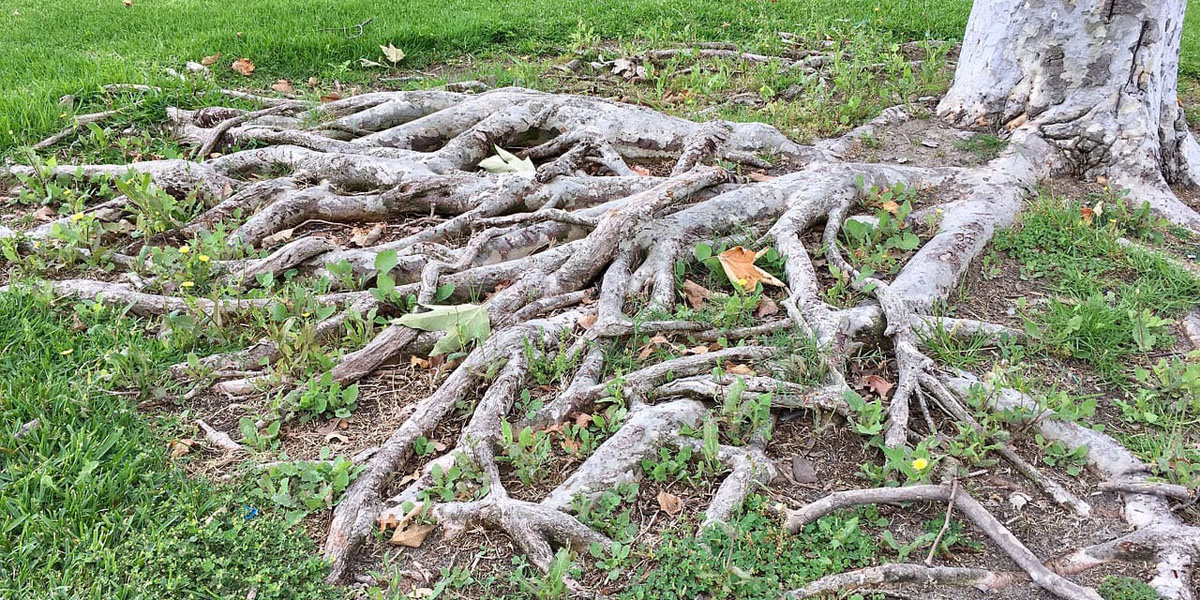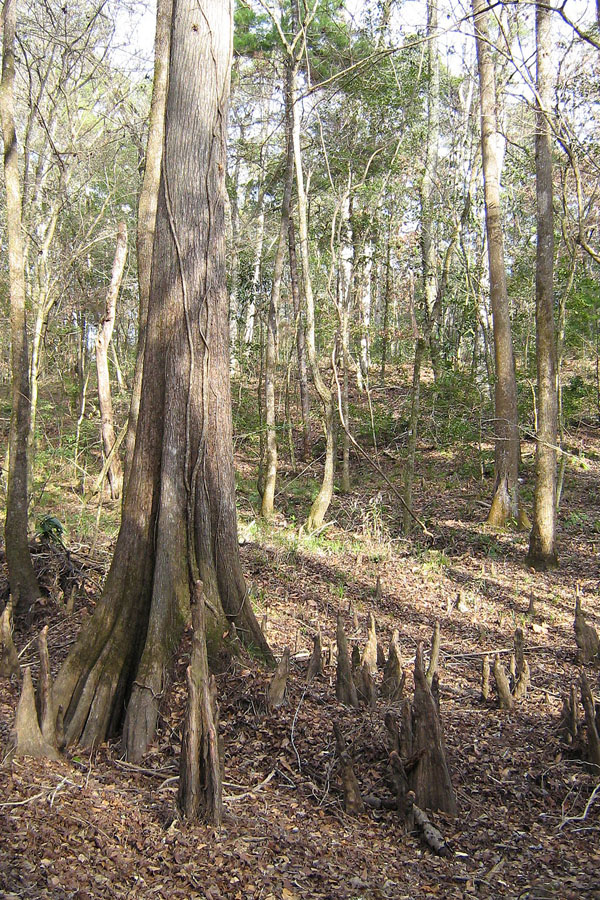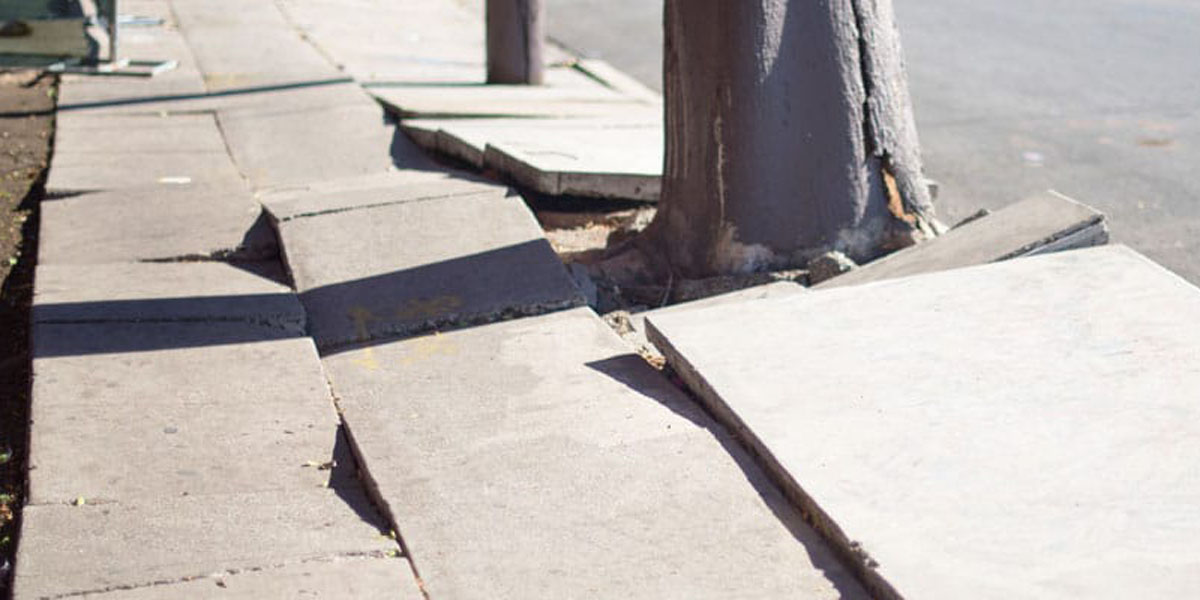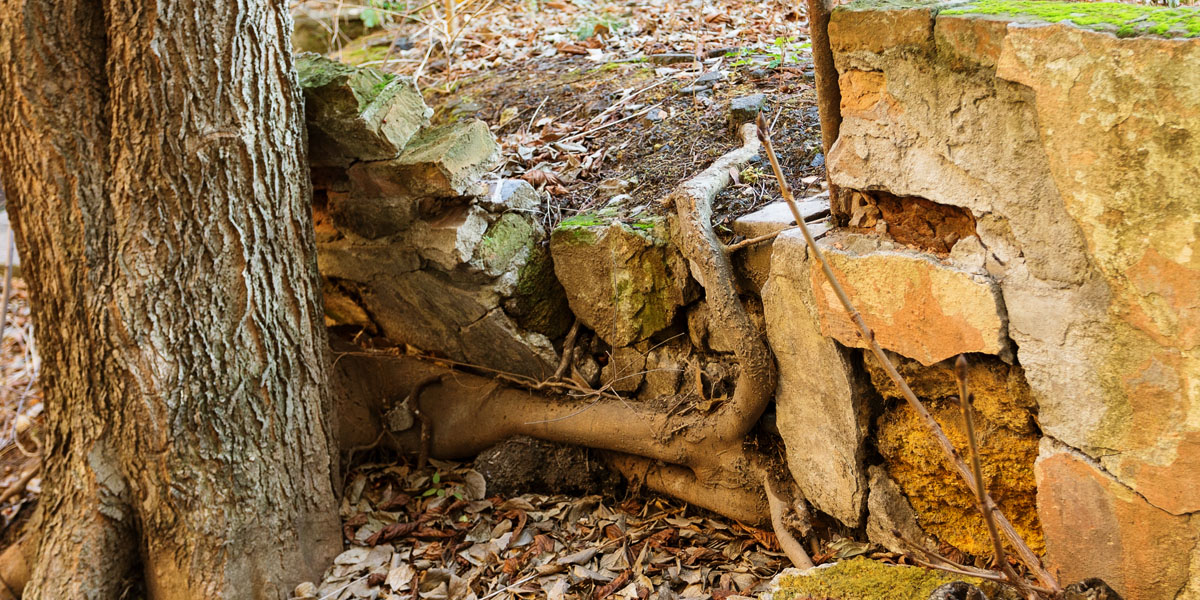Tree roots are important. They act as an anchor, holding trees firmly in the ground during high winds and storms. They are vital in providing water and nutrients to the tree. They even work with fungi in the earth to communicate with other trees and organisms.
You probably don’t really think about tree roots, in fact, until they start causing problems. As residential lots get smaller in the Morristown, NJ area (or homes get larger), there’s less room for trees (and their roots) to grow. As a result, we’re seeing tree roots cause a variety of problems for homeowners, including:
- roots growing above ground,
- cracked and lifted sidewalks, driveways and patios,
- damaged and root-filled sewer lines and water pipes, and
- shifting foundations.
We go over these common problems caused by tree roots below, as well as ways to prevent and/or remedy the damage they cause.
Roots Appear Above Ground

Roots above ground can be a tripping hazard, amongst other things
The main reason we tend to forget about tree roots is that they’re underground. Out of sight, out of mind. But when roots begin to show above the surface, they can become a tripping hazard, make mowing difficult, kill the lawn, and more.
Why do roots grow above ground?

Bald cypress trees have above-ground roots called “knees”
Some trees have roots that naturally appear above ground, no matter the circumstances. One type of tree is the bald cypress, which has root “knees” that grow above ground. Scientists and arborists haven’t yet discovered why this phenomenon occurs, but some hypothesize that it’s to prevent the tree from drowning (yes, trees can drown – and since bald cypress often grows in damp or swampy areas, the knees allow it to “breathe”) and to gather oxygen for the tree.
Most often, however, exposed roots are the result of either soil erosion or from frost heaving. Frost heaving is when the ground continually freezes and thaws, squeezing tree roots and pushing them to the surface.
Can I cover exposed roots with soil to level the ground?
Your initial thought may be to cover the roots with soil, but remember how one of the roots’ jobs is to get oxygen? A layer of soil placed on top of exposed roots will suffocate them. Instead, instead cover roots with organic mulch; it will not only create a more level surface, it will also help retain moisture and regulate the temperature (which means fewer instances of frost heaving).
Just be sure to keep mulch pulled well back from the trunk of the tree and don’t pile it more than 2 – 3 inches deep. Ensure that it lays flat and doesn’t form a dreaded mulch “volcano” around the tree.
What happens if I remove the exposed tree roots?
We advise against removing tree roots that are growing above ground. Cutting roots harms the tree by cutting off some of its supply of water and nutrients, it makes the tree less stable, and invites disease and pests.
However, if above-ground roots are a serious problem, give us a call. Depending on the tree’s health, root structure and location, we may be able to judiciously remove some (no more than 20%) of the smaller exposed roots.
Roots Crack & Lift Sidewalks, Driveways & Patios

Can I move a tree whose roots are damaging my sidewalk?
If the tree has been planted in the past few years and is still young, you may still be able to transplant it to a location where it has more room for its roots to spread. Older trees, however, may not be able to be moved without significant (or even fatal) damage.
What else can I do to stop root damage to my sidewalk, driveway or patio?
If the tree cannot be transplanted, you have a few other options. Repairing or replacing the structure that is buckling is only a temporary solution, so try to move the walkway to give the roots room to grow. Meandering sidewalks and a wooden “bridge” over the roots are some ways that you can move the walkway being damaged.
Another option is to have a tree care professional use an air spade to remove some of the soil beneath the roots. In some instances, this breaks up compacted soil and allows the roots more room to grow. This usually involves removing the driveway or sidewalk to gain access to the roots, so you might want to replace it with one of the options mentioned above.
Can’t I just cut off the problem roots?
This is a “solution” we don’t recommend. As we mentioned earlier, any cutting of the roots is an invitation for disease and stresses the tree. If you take away a tree’s ability to anchor itself, it is more likely to topple in a storm. Plus, the tree roots will grow back, so it hasn’t solved the problem.
Pavers are a possible solution, as they allow water and oxygen to reach the roots. If they do start to crack, they are easy to replace. Check out some other alternative paving methods here (as well as more information about why you should never pave a driveway over tree roots).
Roots Invade Your Sewer System & Water Pipes

Tree roots will go where they can find water – and sometimes that leads them to cracked pipes like sewer lines
How do tree roots get into sewer pipes?
A tree root’s job is to seek out and find water and nutrients for the tree. When it finds a broken or cracked sewer pipe, it has hit the jackpot. They are not strong enough to break into a pipe, but if there is even a small opening, roots can find their way in and eventually take over the system, creating a costly problem for homeowners.
How can I remove roots from my sewer system?
If you’ve ever dealt with this issue, you’ll probably know that there are few options once roots take over any kind of pipes. You can have the roots mechanically cleared from the pipes once a year, or there are a few chemicals that may kill the roots (although this may kill the tree as well). The only way to completely remove the roots from the pipes is to replace them completely, ensuring that there are no leaks or gaps where the roots can “break in”.
Roots Damage Foundations

Tree roots often get the blame for damaged foundations, but a crack has to exist for the tree roots to make their way in
Why do tree roots damage foundations?
One thing you might have noticed throughout these examples of root problems is that it’s never actually the tree’s fault. They can only grow where they are planted, so if they’re planted in the wrong location, they try to make it work. If their roots show up in unexpected places, it’s because they are desperately trying to get enough water, nutrients, and oxygen for the tree to survive. The further out they reach, the more chance the tree has of finding those needed elements.
With roots and foundation issues, the circumstances are the same. Roots can’t go where there isn’t already an issue, so if there are tree roots in your foundation, it’s there because the tree was planted too closely to a building and/or because there was a recent drought or prolonged dry spell in the area. When the soil around your home dries out it can shift, causing the foundation to shift and sometimes crack.
How to Avoid Tree Root Damage
How far should trees be planted from structures and pipes?
Trees should be planted a minimum of 10 feet away from all houses, buildings, structures, walkways, water lines, sewer lines, and driveways. Trees that are known to spread out or that have water-hungry roots should be planted at least 25 feet away, and those that thrive in really wet, swampy areas (such as willows, American elms, and silver maples) have invasive root systems and need even more room to spread out.
Can I prevent tree roots from spreading into nearby foundations or pipes?
Tree roots will grow towards a building in search of moisture, especially if there are shrubs or flowers (or grass) that get watered regularly near the house. Trees will find those tiny cracks and will enter in search of water, similar to how they enter pipe systems.
To prevent this, ensure that your tree is well-watered, especially during dry seasons. Be sure to water at the drip line (the edge of the tree canopy) and not the trunk so that the roots can reach the water.
Will my town let me cut down a tree that’s causing damage?
Roots are vital to a tree’s survival and should be protected whenever possible, but sometimes too much damage has been done. In these instances, the tree might have to be removed and the stump ground to prevent the roots from doing further damage.
Contact us for a consultation if you think a tree may need to be removed as a last option. Remember that many towns in our area of New Jersey have strict permitting and tree removal requirements, but some allow tree removals if they are damaging sidewalks – we’ll be able to tell you if that applies in your case. Just keep in mind that you will have to plant another tree on your property if you have one removed.
In Summary
A little prevention can avoid tree root issues in the future. Be sure to keep your tree healthy, always plant the right tree in the right place, and keep an eye on your sewer lines and foundations to fix issues before they become a bigger problem.
Don’t forget that trees are a valuable resource when planted correctly and when well-maintained. If you need a refresher on some of the benefits that trees provide (and we only mentioned some of them!), check out this blog post.
We also have an article with more information on planting the correct tree, watering, mulching, and more.





